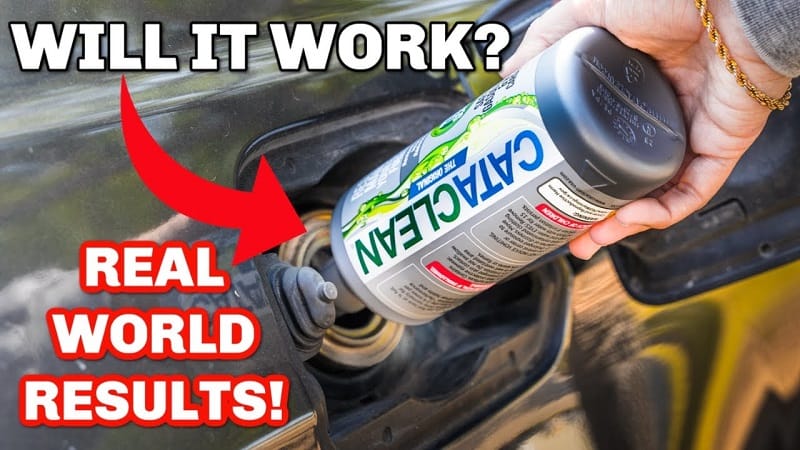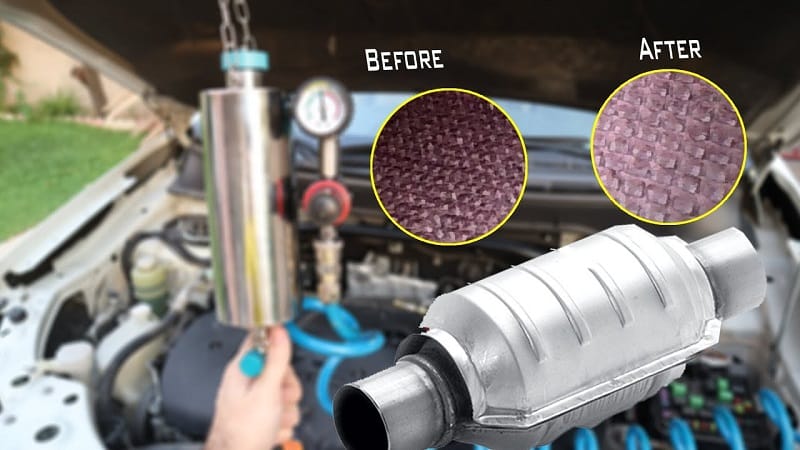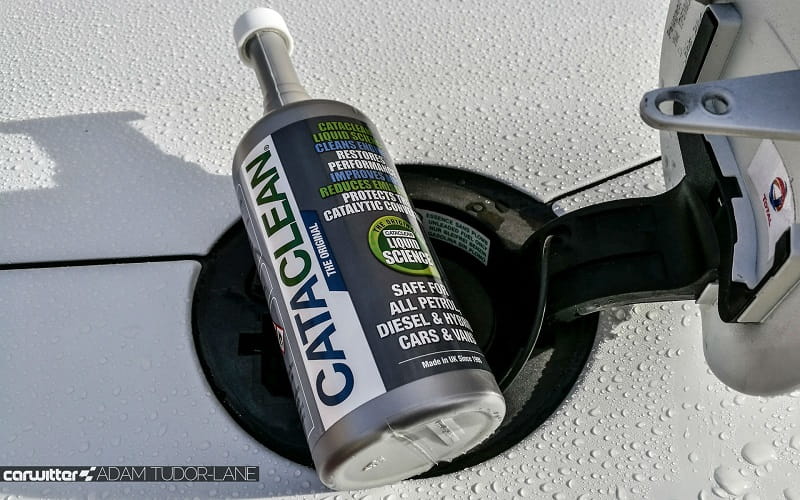This post contains affiliate links. This means I will make a commission at no extra cost to you should you click through and make a purchase [ “As an Amazon Associate, I earn from qualifying purchases.” ]. Read the full disclosure here.
Does Catalytic Converter Cleaner Work? An Honest Look at Fuel Additives and Emission Solutions GuideMechanic.Com The catalytic converter is a critical component of your car’s emission control system. It transforms harmful pollutants into less dangerous gases before they leave your vehicle’s exhaust.
Over time, however, it can become clogged or coated with carbon deposits, leading to performance issues, failed emissions tests, or even triggering the dreaded Check Engine Light with codes like P0420.
With replacement costs often running between $500 to $2,500 or more, many car owners search for a cheaper solution. This is where catalytic converter cleaners come into the picture. But a major question remains:
Do catalytic converter cleaners actually work?
Let’s dive deep into what they do, how they work, when they can be effective—and when they won’t help at all.
Does Catalytic Converter Cleaner Work? An Honest Look at Fuel Additives and Emission Solutions
What Is?

A catalytic converter cleaner is a type of fuel additive that is poured into your vehicle’s gas tank. As the engine runs, the cleaner travels through the fuel system, combustion chamber, and exhaust system. It’s designed to:
- Break down carbon and soot that may accumulate in the catalytic converter
- Clean oxygen sensors, EGR valves, and injectors
- Reduce emissions, especially hydrocarbons and nitrogen oxides
- Improve fuel economy and performance
- Help clear OBD-II trouble codes, particularly P0420 (catalyst efficiency below threshold)
Common brands include Cataclean, Sea Foam, Liqui Moly, STP, and Chevron Techron.
How Catalytic Converters Get Clogged
A healthy catalytic converter should last the life of your vehicle. But in reality, several things can cause premature failure or clogging:
- Unburned fuel entering the exhaust from misfires or rich fuel mixtures
- Oil or coolant leaks entering the combustion chamber
- Low-quality fuel leaving behind excessive carbon residue
- Short trips that prevent the exhaust from reaching high enough temperatures to burn off contaminants
Over time, these conditions can cause buildup on the internal honeycomb structure of the catalytic converter, restricting exhaust flow and reducing its effectiveness.
So, Does Catalytic Converter Cleaner Actually Work?
✅ Yes — In Some Cases
Catalytic converter cleaners can work, but their effectiveness depends on the condition of your vehicle and the severity of the problem.
When Cleaners Are Effective:
- Minor carbon buildup: If your converter is beginning to clog due to mild carbon or soot, a cleaner can help dissolve these deposits.
- Emissions test preparation: Many people report passing emissions tests after using cleaners like Cataclean or Sea Foam.
- OBD-II codes: Cleaners have been known to help clear trouble codes like P0420, at least temporarily.
- Preventative maintenance: Using a cleaner every few thousand miles can help keep your fuel and exhaust systems clean.
When Cleaners Don’t Work:
- Severe clogging: If the converter is heavily coated or melted inside, no chemical cleaner will restore it.
- Physical damage: Broken, cracked, or rusted catalytic converters need replacement.
- Underlying issues: If a misfire, oil leak, or bad sensor caused the clog, the cleaner may work temporarily but the problem will return.
🧠 Important: Catalytic converter cleaners are not miracle products. They work best as a preventative or mild corrective solution—not a replacement for a broken converter.
Real-World Evidence and Reviews

Thousands of vehicle owners have used catalytic converter cleaners with mixed but often positive results. Let’s look at some real-world feedback.
🔹 Positive Experiences
“I used Cataclean and it cleared my Check Engine Light. I was getting P0420 for weeks. After driving for 20 minutes post-treatment, the light went off and stayed off.”
“I had a failed smog test and didn’t want to spend $1000 on a new converter. Used Liqui Moly, drove for 50 miles, and passed the retest.”
“I use Sea Foam every 5,000 miles as part of regular maintenance. Keeps the engine and converter clean.”
🔸 Mixed or Negative Reviews
“I tried two bottles of cleaner. It helped performance a little, but the code came back a week later.”
“It didn’t fix my P0420. Turns out my oxygen sensor was bad.”
The results vary greatly depending on engine condition, driving habits, and the exact issue.
How to Use Catalytic Converter Cleaner Properly
To get the best results, follow these general steps:
- Wait until your fuel tank is around 1/4 full. A more concentrated mix gives better cleaning power.
- Pour the entire bottle of cleaner into the fuel tank.
- Drive your vehicle for at least 15 to 30 minutes, preferably on the highway at higher RPMs. This helps the converter reach the high temperatures needed to burn off residue.
- Repeat as necessary or as instructed by the product (usually every 3,000 to 5,000 miles).
📌 Tip: If you’re using the cleaner before a smog check or to try to clear a code, do it a day or two before the test to allow time for the system to clean and reset.
Top Catalytic Converter Cleaners to Consider
Here are a few of the most popular and effective options on the market:
1. Cataclean
- Widely recommended
- EPA-approved
- Works with gas, diesel, and hybrid vehicles
- Great for code P0420
2. Liqui Moly Catalytic System Cleaner
- German-engineered
- Especially effective for European vehicles
- Cleans combustion and exhaust components
3. Sea Foam Motor Treatment
- All-purpose fuel and oil additive
- Not targeted solely at converters, but great for overall cleaning
4. STP Catalytic System Cleaner
- Budget-friendly
- Available in most retail auto stores
- Good for maintenance use
When to See a Mechanic Instead

If you’ve tried a cleaner and are still seeing symptoms like:
- Persistent Check Engine Light
- Strong sulfur or rotten egg smell
- Noticeable loss of power
- Loud rattling from under the car
- Failed multiple emissions tests
it’s time to visit a professional. Your converter may need to be replaced, and a mechanic can diagnose any upstream issues causing the damage.
Final Verdict: Do Catalytic Converter Cleaners Work?
✅ Yes, catalytic converter cleaners do work—but only under the right conditions.
They’re not a miracle fix, but they are an effective first step in solving emission-related issues or keeping your exhaust system clean. When used correctly, they can save you hundreds (or even thousands) in repair costs.
Best Use Cases:
- Mild converter clogging or buildup
- Preventative maintenance
- Emissions test prep
- Code P0420 (when no other mechanical failure exists)
Remember: if the root cause of your problem is mechanical (like a bad spark plug, injector, or oxygen sensor), no cleaner will solve it long-term.
Summary: Key Takeaways
- Catalytic converter cleaners can dissolve carbon and soot, improving emissions and performance.
- They work best for minor clogs, preventative care, or as a temporary fix.
- For physical damage or severe clogging, replacement is the only solution.
- Use trusted products like Cataclean, Sea Foam, or Liqui Moly.
- Always address the root cause to prevent recurrence.
- Lifted Ford Diesel Trucks for Sale - December 15, 2025
- Lifted GMC Diesel Trucks for Sale - December 14, 2025
- Lifted Chevy Diesel Trucks for Sale - December 13, 2025
